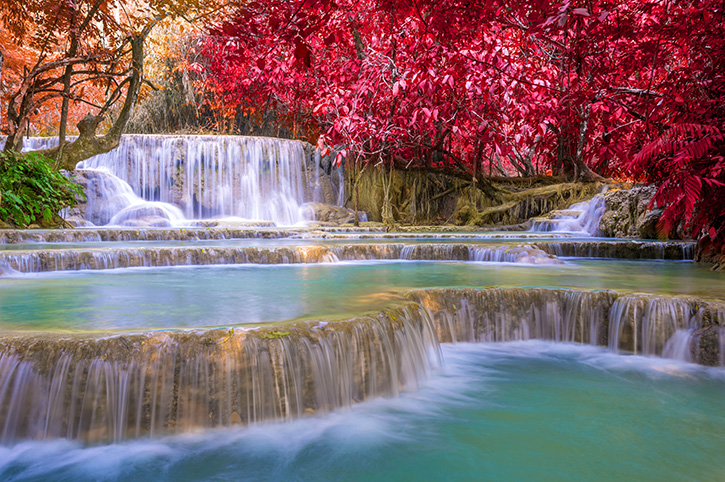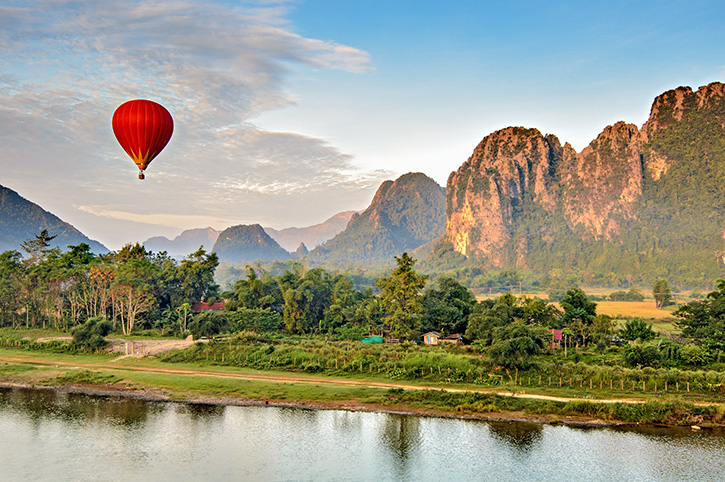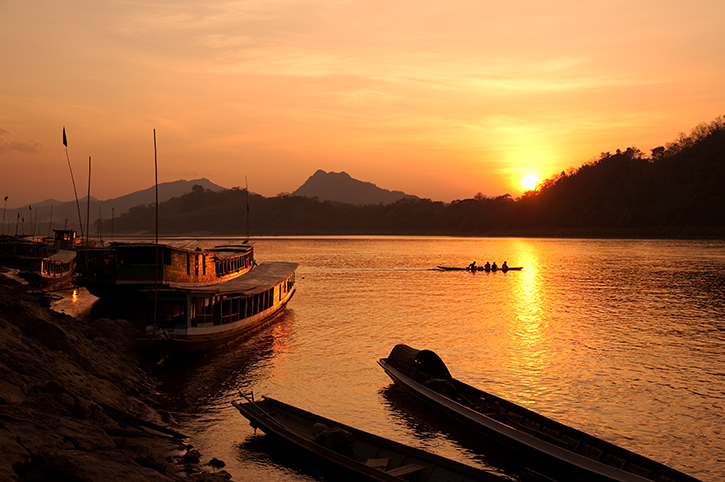
Any traveller looking for a country with a history of mass tourism – where the stops and visits follow one after the other at a frantic pace, where transfers are fast and stressful, and where hotels are all the same – certainly won’t find it in Laos.
But for those in search of a slice of relaxation, a place where the inhabitants really take the time to live or a place where visitors are greeted with a sweet and warm smile, there are many places to visit in Laos that are most definitely worth serious consideration.
From the highlands in the north of the country to the 4000 islands in the Mekong River to the south, visitors will fall in love with a country where time often seems to have stopped. Here are our ten best places to visit on a Laos holiday.
With all the peaceful charm of a provincial capital, Vientiane is safe from the hysterical frenzy of most of the major capitals of Southeast Asia. Here, tourists can stroll serenely and discover the cultural treasures of the city.
But if you have time to devote more interest to the capital than just the major sites presented by most tour guides, the city of Vientiane is full of little wonders of everyday life and treasures of authenticity.
Two or three days here should be enough to get a real flavour of the place and still give you time to move on to Laos’ other wonders, though if you are short on time we would suggest seeing the city’s highlights on a one day Vientiane City Tour. Visit Vientiane’s markets, temples and handicrafts all around, and experience the city and its normal everyday life.

The national symbol of Laos, That Luang, is an imposing golden monument reflecting both the Buddhist religion and Laotian sovereignty. Built in 1566, the architecture of this temple is a combination of Asian pagoda architecture and the traditional Laotian temple specific to this particular region.
Other Vientiane temples such as Wat Si Saket temple, Wat Haw Pha Kaeo temple, Wat Si Muang and Wat Ong Teu temple should also be on the list to visit for anyone hoping to understand the culture and beliefs of Laotian people and to discover the collections of sacred art and superb Lao Buddhist sculptures within.
Away from the capital, however, there a myriad of other things to do in Laos. Probably the most beautiful city in the country, and also recognized as a UNESCO World Heritage Site, is Luang Prabang. With its religious monuments and preserved colonial buildings, this city is also the ancient capital of Laos and it will surprise and beguile with its serenity and spirituality.
A stay in Luang Prabang also affords travellers the perfect opportunity to practice original activities to apprehend the Laos culture through crafts and cooking or through its rural lifestyle linked to its agriculture.
In the mornings at around 5am, the ceremony of Tak Bat sees hundreds of monks roam the streets of Luang Prabang in silence to collect the food of their day, humbly distributed by the local population on their way. Far from a simple trip to a beauty spot, a visit to Luang Prabang is a worthwhile cultural experience.
Finally, this enchanting city is also the starting point for other excursions which are not to be missed in the area: the caves of Pak Ou with their hundreds of effigies of Buddha who seems to watch over the waters of the Mekong, and the waterfalls of Kuang Si, which are among the most beautiful in Asia and where you can swim in natural pools. Combine Luang Prabang with Vientiane on a Highlights of Laos small group tour.

Long forgotten by travellers, the region of Vang Vieng is now accessible by a new road from Luang Prabang. That makes it a perfect next destination for a trip to Laos, even just travelling along the road is an exceptional experience: it is bordered by ethnic minority villages and crosses beautiful mountain scenery.
Until recently, the region was the playground for backpackers and party-goers seeking freedom far from the modern world. The Laotian authorities have put a stop to that in recent times – now, the region retains its serenity and welcomes travellers to discover its natural environment and amazing landscapes of karst “sugar loaf” set amidst rice fields and hills.
Vang Vieng is a very beautiful green area, famous for its caves and waterfalls, cliffs and limestone loaves. It is especially famous, too, for water sports on the Mekong.
Northern Laos is a mountainous region with lush vegetation, crisscrossed with rivers and rice paddies, where modern development has not yet altered the local lifestyle.
This sparsely populated rural area is characterized by its cultural and ethnic diversity. Many minority ethnic communities live off main roads and maintain their ancestral lifestyles, beliefs and rituals. The exceptionally beautiful north of Laos offers the opportunity for authentic getaways and is aimed at travellers who wish to immerse themselves in the discovery of Laos and Asia where time seems to have no hold.
Discover the natural riches of northern Laos with its beautiful landscapes of mountains, rice fields, jungles and rivers, and walk in the rice fields and small mountain paths far from the tourist circuits.
For more adventures, spend a few hours in a motor canoe on the rivers that crisscross northern Laos and discover the customs and traditional way of life of the people who live there.

Champasak is one of the most visited provinces of Laos and has a population of about 50,000 inhabitants. It is formed by Pakse, the Bolovens Plateau, Paksong, Champasak and Si Phan Don – the 4000 islands mentioned earlier.
Situated near Laos’s border with Thailand and Cambodia, Pakse is located at the confluence of the Mekong river and its much smaller tributary, the Xe Don. It is the capital of the province, and because of the bridge that crosses the Mekong, the city is quickly developed as a major commercial area and tourist destination thanks to the ease of access it brings.
Holidays to Laos and South East Asia by Freedom Destinations.
The Bolovens Plateau sits at 1250 metres above sea level and is 50km from the town of Pakse. Here, you’ll find sumptuous landscapes, spectacular waterfalls, and primary forests; the plateau is also famous for its coffee as well as tea and pepper.
The region is also home to ethnic villages and other unexplored corners. Best known for being home to some of the most spectacular waterfalls in Southeast Asia, this region attracts visitors to its stunning geographical features including Tad Fane Falls and Dong Hua Sao.
While the Plateau’s fertile plains allow farmers to produce some of the best teas in the country, and coffee remains the main agricultural export of Laos, tourism has become an important source of income for the local population because this region offers unlimited trekking and touring opportunities as well as an unmistakably authentic feel.
If you are travelling to this part of Laos, do note that here, the weather is in general cooler than the rest of the country – especially during the night.

Along the banks of the river, the Wat Phu temple – known as the mountain temple, offering spectacular views – is a UNESCO World Heritage Site and has been since 2002. This temple, however, dates from the pre-Angkorian period and is built in the traditional Khmer architecture and was initially dedicated to the Hindu religion.
Wat Phu is considered one of the oldest archaeological sites in Laos. A temple on site was built around the 5th century, but most of the buildings found in the complex are from the 11th to the 13th century. Like other notable Khmer architecture in Southeast Asia, it was built using sandstone, laterite clay and bricks. Among the many sculptures are dedications to Indra, the Hindu god of war, storms and rainfall, who is riding a three-headed elephant and Vishnu riding a Garuda – a mythical eagle-like bird.
Take a boat trip on the Mekong to visit the 4000 islands region of Si Phan Don with wonderful waterfalls and immerse yourself in life on the banks of the mighty river.
This area is one of the most relaxing and stunning places in Laos. Despite boasting literally thousands of river islands, we think at least three of them offer particular interest:
Don Khong: the most peaceful. With its banks lined with palm trees, it is the ideal place for a bike ride from village to village and through the rice fields.
Don Det: the most modest. With its many small market stalls and bungalows, locals live here in only very basic comfort. On this island, more than elsewhere in the region, time seems to have stopped and that’s no bad thing!
Don Khone, Don Det’s neighbour: Yet another dream setting for beautiful walks or bike rides. These last two islands are connected by a bridge, a vestige of French colonisation, which at the time supported the only railroad of the country.

For those with a bit more time to explore the region, amazing discoveries such as the Phabeng Falls with its impressive Mekong river rapids, the Lippi Falls, the Irrawaddy freshwater dolphins and the small town of Champasak with its old colonial buildings and traditional Lao houses are special spots to visit.
Laos and the Mekong are inseparable: the latter is at the very heart of the life of its inhabitants and as a landlocked country in a region whipped by the sea it’s obvious how important the river really is. Several sections of its course and its tributaries are navigable and that makes a boat tour one of the best ways to see this stunning country.
Due to its geographical location, a trip to Laos is often combined with one of its neighbouring countries, and the contrasts between Vietnam or Thailand, or even Cambodia, and this untapped and relaxed land only make this a better way to enjoy it even more. Some of our most popular multi-country itineraries are Vietnam & Laos Explorer, Sights of Cambodia & Laos and Laos Highlights & Thai Beaches.
As holidays to Laos start to gain popularity, its hidden gems will fast become well-known, so take this opportunity to explore a country currently like no other and visit the ten best places to visit in Laos before everyone else.